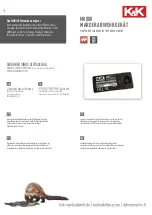
47
F O R M
DVR
®
2400 and DVR
®
2500 Digital Voltage Regulator
Installation, Operation and Maintenance Manual
SB0056E
Revised
November 2018
Regal Beloit America, Inc.
100 East Randolph Street
Wausau, WI 54402-8003
www.regalbeloit.com/Brands/
Marathon-Generators
•
Field Current Set Point
is editable in FCR Regulation Mode. This value
represents the desired field current of the regulator.
•
Droop
is the maximum percentage of Regulator Voltage Set Point
allowed for adjustment of voltage during load sharing. Refer to
for a detailed description of Load Sharing.
•
PT Ratio
is the value of the potential transformer ratio of the system.
The generator output voltages displayed in the Generator tab of the Me-
tering panel are equivalent to the voltages displayed in the Regulator tab
multiplied by this value.
Example:
A PT with a 13,200 Volt primary rating and a 240 Volt second-
ary rating would have a PT Ratio of 55.
•
CT Ratio
is the value of the current transformer ratio of the system. The
generator output currents displayed in the Generator tab of the Meter-
ing panel are equivalent to the currents displayed in the Regulator tab
multiplied by this value.
Example:
A CT with an 800 A primary rating and a 5 A secondary rating
would have a CT ratio of 160.
•
Slope Multiplier
is the factor applied to the base slope for voltage
roll-off with respect to frequency in a V/Hz mode. Refer to
for a detailed description of Generator Under
Frequency.
•
Under Frequency Knee
is the value of frequency below which the reg-
ulator operates in a Volts-per-Hertz mode. Refer to
for a detailed description of Generator Under Frequency.
Auxiliary Input Configuration (4c)
This panel contains controls for modifying the functionality of the auxiliary
input.
•
Auxiliary Input Type
configures the auxiliary input as a set point mod-
ifier, a slope multiplier modifier or disabled. Refer to
for a detailed description of the Auxiliary Input function.
Note:
If Aux input type is selected as Dynamic Slope (2500 only), the UF
Slope setpoint field will be locked as this register dynamically updates with
the applied AUX voltage.
•
Aux. Control Scale Factor
is used when the auxiliary input port is con-
figured as “Auxiliary Control1” or “Auxiliary Control2” This value scales
the auxiliary input. Refer to
Section – Features and Protection
for a de-
tailed description of the Auxiliary Input function.
•
AUX Voltage
is used to select the range of AUX voltage applied to the
regulator. This feature is only available in the 2500. For the 2400 this is
by default set to +/-3V. The 2500 provides additional selections of +/-5V
and +/-10V.
•
Dynamic Slope
Is used to select the polarity of the dynamic slope
feature. This determines the direction of slope variation when a 0 - 5V
is applied to Aux Input. This feature is only available in the 2500. Refer
to
Section – Features and Protection
for a detailed description of the
Dynamic Slope function.
Offset Display (4d)
This panel displays the offsets contributing to the modification of the set
point for the currently selected regulation mode.
•
Contact Offset
displays the effect that the contact inputs have on the
regulator set point value. Refer to
Section – Features and Protection
for
a detailed description of the UP and DOWN contact input functions.
•
Auxiliary Offset
displays the effect that the auxiliary input has on the
regulator set point value. Refer to
Section – Features and Protection
for
a detailed description of the Auxiliary Input function.
•
Droop Offset
displays the effect that the regulator’s droop function has
on the regulator set point value. Refer to
Section – Features and Protec-
for a detailed description of the Load Sharing function.
•
CAN Offset
displays the effect that the Set Point Adjust CAN message
has on the regulator set point value. Refer to the DVR
®
2500 CAN Bus
Interface User Guide for a detailed description of the Set Point Adjust
message.
•
Step Offset
displays the effect that the step change from the Metering
tab has on the regulator set point value. Refer to
for a detailed description of the step change input functions.
•
Total Set Point
displays the total reference to the controller. This refer-
ence value is comprised of the set point and any offsets currently active.
















































